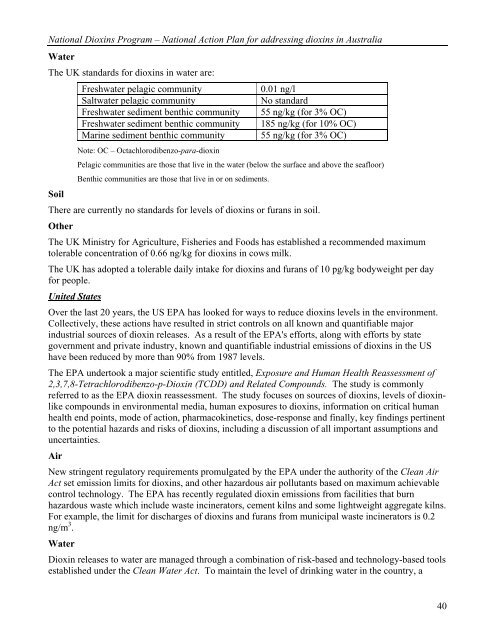National Action Plan for Addressing Dioxins in Australia
National Action Plan for Addressing Dioxins in Australia
National Action Plan for Addressing Dioxins in Australia
- No tags were found...
You also want an ePaper? Increase the reach of your titles
YUMPU automatically turns print PDFs into web optimized ePapers that Google loves.
<strong>National</strong> <strong>Diox<strong>in</strong>s</strong> Program – <strong>National</strong> <strong>Action</strong> <strong>Plan</strong> <strong>for</strong> address<strong>in</strong>g diox<strong>in</strong>s <strong>in</strong> <strong>Australia</strong>WaterThe UK standards <strong>for</strong> diox<strong>in</strong>s <strong>in</strong> water are:Freshwater pelagic communitySaltwater pelagic communityFreshwater sediment benthic communityFreshwater sediment benthic communityMar<strong>in</strong>e sediment benthic community0.01 ng/lNo standard55 ng/kg (<strong>for</strong> 3% OC)185 ng/kg (<strong>for</strong> 10% OC)55 ng/kg (<strong>for</strong> 3% OC)Note: OC – Octachlorodibenzo-para-diox<strong>in</strong>Pelagic communities are those that live <strong>in</strong> the water (below the surface and above the seafloor)Benthic communities are those that live <strong>in</strong> or on sediments.SoilThere are currently no standards <strong>for</strong> levels of diox<strong>in</strong>s or furans <strong>in</strong> soil.OtherThe UK M<strong>in</strong>istry <strong>for</strong> Agriculture, Fisheries and Foods has established a recommended maximumtolerable concentration of 0.66 ng/kg <strong>for</strong> diox<strong>in</strong>s <strong>in</strong> cows milk.The UK has adopted a tolerable daily <strong>in</strong>take <strong>for</strong> diox<strong>in</strong>s and furans of 10 pg/kg bodyweight per day<strong>for</strong> people.United StatesOver the last 20 years, the US EPA has looked <strong>for</strong> ways to reduce diox<strong>in</strong>s levels <strong>in</strong> the environment.Collectively, these actions have resulted <strong>in</strong> strict controls on all known and quantifiable major<strong>in</strong>dustrial sources of diox<strong>in</strong> releases. As a result of the EPA's ef<strong>for</strong>ts, along with ef<strong>for</strong>ts by stategovernment and private <strong>in</strong>dustry, known and quantifiable <strong>in</strong>dustrial emissions of diox<strong>in</strong>s <strong>in</strong> the UShave been reduced by more than 90% from 1987 levels.The EPA undertook a major scientific study entitled, Exposure and Human Health Reassessment of2,3,7,8-Tetrachlorodibenzo-p-Diox<strong>in</strong> (TCDD) and Related Compounds. The study is commonlyreferred to as the EPA diox<strong>in</strong> reassessment. The study focuses on sources of diox<strong>in</strong>s, levels of diox<strong>in</strong>likecompounds <strong>in</strong> environmental media, human exposures to diox<strong>in</strong>s, <strong>in</strong><strong>for</strong>mation on critical humanhealth end po<strong>in</strong>ts, mode of action, pharmacok<strong>in</strong>etics, dose-response and f<strong>in</strong>ally, key f<strong>in</strong>d<strong>in</strong>gs pert<strong>in</strong>entto the potential hazards and risks of diox<strong>in</strong>s, <strong>in</strong>clud<strong>in</strong>g a discussion of all important assumptions anduncerta<strong>in</strong>ties.AirNew str<strong>in</strong>gent regulatory requirements promulgated by the EPA under the authority of the Clean AirAct set emission limits <strong>for</strong> diox<strong>in</strong>s, and other hazardous air pollutants based on maximum achievablecontrol technology. The EPA has recently regulated diox<strong>in</strong> emissions from facilities that burnhazardous waste which <strong>in</strong>clude waste <strong>in</strong>c<strong>in</strong>erators, cement kilns and some lightweight aggregate kilns.For example, the limit <strong>for</strong> discharges of diox<strong>in</strong>s and furans from municipal waste <strong>in</strong>c<strong>in</strong>erators is 0.2ng/m 3 .WaterDiox<strong>in</strong> releases to water are managed through a comb<strong>in</strong>ation of risk-based and technology-based toolsestablished under the Clean Water Act. To ma<strong>in</strong>ta<strong>in</strong> the level of dr<strong>in</strong>k<strong>in</strong>g water <strong>in</strong> the country, a40
















